The other day, His Excellency Most Rev. Salvatore Cordilone of San Francisco celebrated a Pontifical Mass at the Throne at the National Shrine of the Immaculate Conception. It was televised. A new musical Mass setting was used and new vestments were designed. All in all it was wonderful and all involved are to be thanked and congratulated.
That said, under the post in which I wrote about the Mass (HERE – VIDEO!) some one asked…
QUAERITUR:
Father, why are the two “deacons” with him not wearing surplices?
Yes, I found that a little puzzling.
What is this about? At these Pontifical Masses, the bishop can be accompanied by two Assistant Deacons, who help put the miter on and off, etc. They wear dalmatics, as deacons, though they can be ordained priests. They wear their choir dress with the dalmatic over. Thus, you expect them to wear also the surplice under the dalmatic. When that is done, they were also the amice over the surplice before putting on the dalmatic.
What happened at this last Mass?
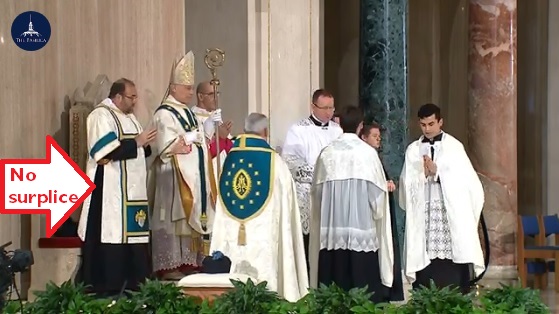
A little strange.
Let’s check out what happened at other televised Pontifical Masses at the same Shrine.
When Bp. Slattery celebrated…
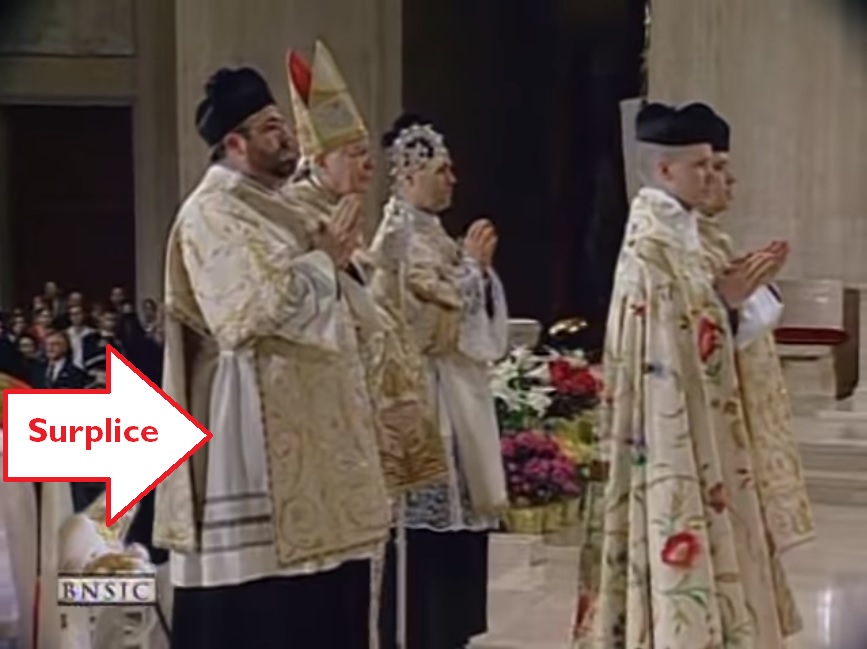
When Archbishop Sample celebrated.
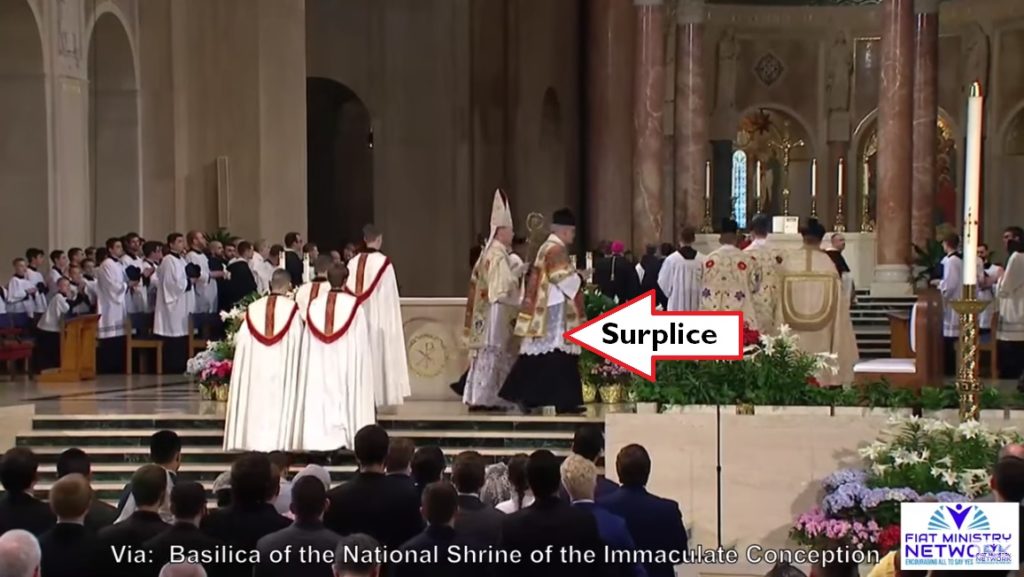
Elsewhere, here in Madison, the Extraordinary Ordinary of happy memory (almost one year ago…), often celebrated these Masses. Here’s a shot. Yes. Surplices. In this small space we did what I’ve seen done in narrow spaces in Rome and I, as MC, put the sacred ministers on the altar steps.
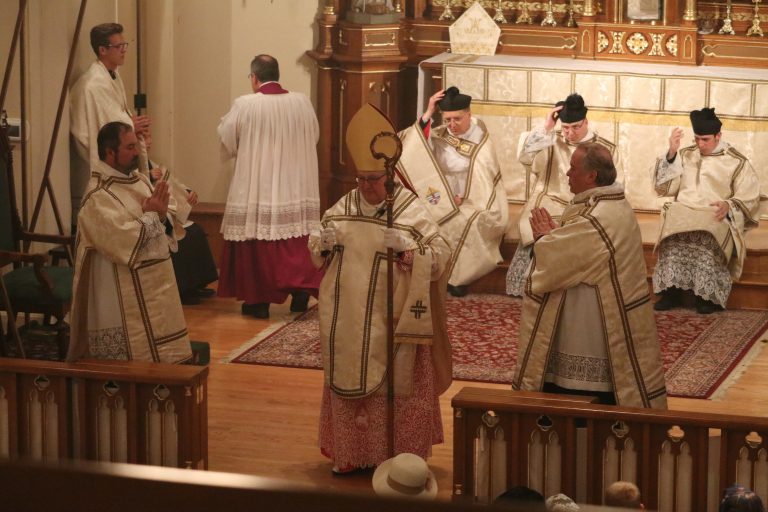
Card. Burke in Minneapolis. Yup. Surplices on the Assistant Deacons.
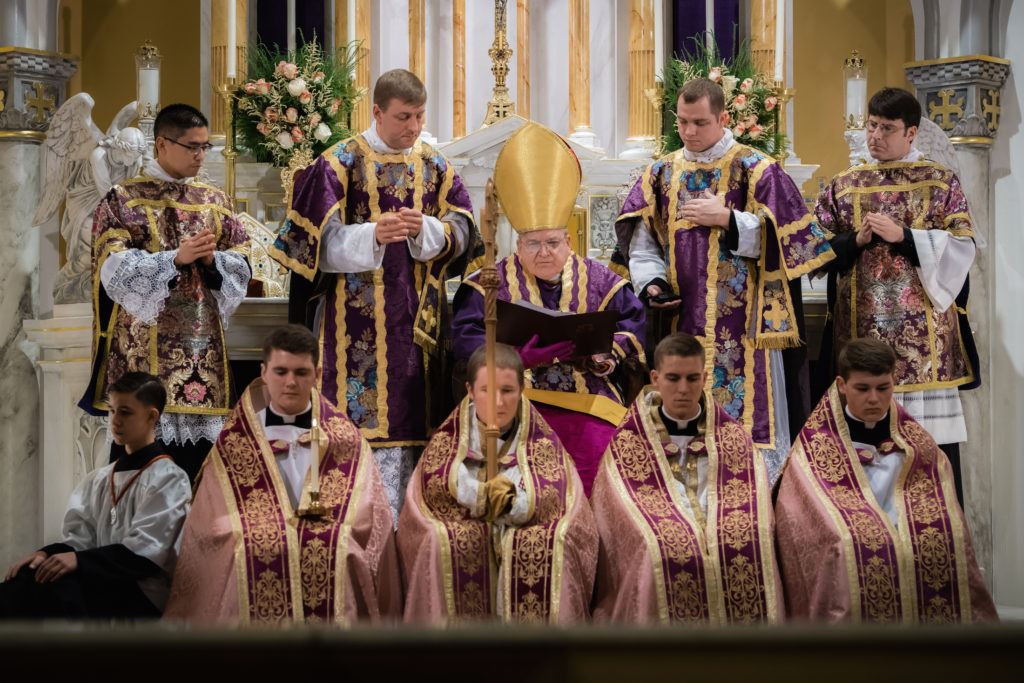
What do manuals say?
Stehle says that, before Mass, the Assistant Deacons wear their choir dress – cassock, surplice and biretta – to accompany the bishop to visit the Blessed Sacrament and then take him to where the bishop will vest. Then they go apart and put on the amice and dalmatic. They are not instructed to remove their surplice. Instead, it seems as if they are to put the amice on over the surplice and then the dalmatic over all. However, Stehle says that, at the end of Mass, the Assistant Deacons accompany the bishop to the throne and then “go to resume their surplices”. That sounds like they might remove their dalmatics and amices and then put on surplices that they had previously removed. Otherwise, it could be interpreted as simply removing their dalmatics and amices and then going back to the bishop in the surplices they were wearing beneath the amices. In other words, they resumed the dress in which they began, “resume” not necessarily meaning putting on something removed. The Assistant Priest is described by Stehle at the beginning of Mass wearing “amice and cope over his surplice”.
In processions with the Blessed Sacrament, priests and deacons wear their proper vestment over the surplice and amice.
In one commentary I saw – contra Trimeloni – in some places Assistant Deacons could wear albs. If albs, then surely surplices.
Collins says that the Assistant Deacons vest in the amice and dalmatic over the surplice (Vol 2, p. 53).
Reworking Fortescue O’Connell (silent on Pontifical Masses), Reid says that the Assistant Deacons put the amice and dalmatic on over the surplice (p. 200).
Trimeloni says that, for a Pontifical Mass, there is prepared in the sacristy (or wherever the bishop vests), surplices, amices and dalmatics for two Assistant Deacons. That means that they put them on (p. 756). Also, after the recitation of Terce, Trimeloni says that the Assistant Deacons, “go to put on over the surplice (sopra la cotta), the amice and dalmatic” (p. 771). Not much doubt there.
So, is this a case of auctores scinduntur? No. I don’t think so. I am going with an interpretation of Stehle that is consistent with the others. “Resume” means returning to being only in cassock and surplice.
It seems to me that the Assistant Deacons ought to have been vested in the surplice, with the amice and then dalmatic over all. I won’t hazard a guess as to why this choice was made other than, perhaps, a strict reading of Stehle was chosen without checking other sources.
We had better go back to the Shrine and do the whole thing over again with surplices on those Assistant Deacons! Let’s repeat it often!
Lastly, a note about these ceremonial manuals.
There is interplay between the manualists, each pinging off the others. However, each manual seeks to describe what is done to follow the written rubrics and solve the problems of what is not written within their spaces and with their personnel available. Some MCs solve their particular problems with a little creativity, but also within the “genius” of the rubrics, of the rite. For example, a Pontifical Mass in a cramped space might require that we place sacred ministers on the altar steps rather than with a chair for the Assistant Priest and sedilia for the Deacon and Subdeacon. This isn’t wrong. It’s a variation that is well founded within the rites. Hence, in Madison, where we have had probably more Masses at the Throne in recent years than anywhere else, we made choices according to which church we are in (there is no cathedral).
The Roman Rite has strong bones and structures and strictures. It is also flexible. We mustn’t be inflexible when it comes to the rites. One manual doesn’t solve all issues. One manual is not the be all and end all for our rites. Reading widely and then doing it slowly but surely teaches those doing it how it is to be done. Fabricando fabri fimus! You become a carpenter by doing carpentry. By immersing in the rites, reading the experiences of those in the past, you get a sense of the “genius” of the rite. “Genius” is a Roman concept which I am borrowing and baptizing. The ancient Roman “genius” was a tutelary spirit that accompanied a person from birth to death, fate-like, or spirits that went with offices. I don’t mean that pagan thing, which was demonic and to which Christians were forced to sacrifice or suffer. I mean something more like Romanitas when it comes to the Roman Rite. I mean something more like Gesamtkunstwerk, a vision that integrates all the elements of texts, music, architecture, movement, ornament, etc. This isn’t something that springs Athena-like from forth a single head. It is rooted in generation upon generation of shared experience around a singular purpose. And in liturgical worship that focus rests in the virtue of Religion, giving to God what is His due and doing so, incarnationally, in the Roman way.
We are our rites. To know ourselves – which is necessary – we have to know our rites. And the way the rites are known and used has a simultaneous interplay with our environment and exigencies.
Enough for now.
Suffice to say that Roman Catholic priests really ought to know their Roman Rite. Really know it, be in it, resound with it.
UPDATE:
Some have asked about liturgical sources.
Stehle
Trimeloni
Fortescu-O’Connell/Reid
Collins


































Fr.
What are the manuals you write of….Stehle, Collins, Reid, and Trimeloni?
I wondered about the surplices, too. Thank you for the citation from Stehle. This is interesting. I think it might be related to wearing the surplice under the alb (when you have no right to wear the rochet) according to the pre-1962 Ritus servandus. So, it would have been only natural to wear a surplice also as assistant deacon.
You wrote:
“A Pontifical Mass in a cramped space might require that we place sacred ministers on the altar steps rather than with a chair for the Assistant Priest and sedilia for the Deacon and Subdeacon. This isn’t wrong.”
Not only is it not wrong, but one of my favourite Roman customs! Thanks for your comments on the “genius” of the Roman rite.
Maybe they ran out.
However, every good national shrine should keep a surplus of surplices.
Worried? No. Simply curious. Thank you, Father, for the response. So very much to learn and I love it. We are our rites. Amen. Amen. Amen.
The European custom was that the ADs wear amice over surplice, then dalmatic.
The American custom from the Baltimore Ceremonial (which in my mind, is the customary manual which should be followed in the U.S., seeing as it was promulgated by the U.S. Bishops as an official ceremonial manual) suggests that the AD wear amice, alb, cincture, and dalmatic. They would not wear a surplice.
Neither of these customs have dalmatic and amice only. Quite frankly, it looked especially bad with the mismatch between the colors of Msgr Pope and the other Monsignor in his purple. An nice alb would have solved this problem pretty well.
I’d say another critique is that a whole different ceremony was used here for vesting than with Msgr Sample’s Mass. Why? It seems like the last thing we want to encourage in big public events like this is confusion by different options being chosen.
Again, the Baltimore Ceremonial provides some good idea of what to do, and prefers vesting in the Sacristy or in a side chapel during Terce, and not the Sanctuary, unless there is no room.
I know it’s nitpicking, but then again, given these things are becoming more normal, it would be good to have some consistency and order, lest we just turn them into another opportunity to show off. So I would encourage us to not only go traditional, but go back to the American customs and tradition in America.
If the above post wasn’t clear enough :
Let’s Make American Liturgy Great Again.
“What are the manuals you write of….Stehle, Collins, Reid, and Trimeloni?”
Tell me about it! I only have Fortescue and O’Connell (and Elliott) in my library!
A new idea for Z Stuff? MALGA (Make American Liturgy Great Again) hats!
Fr_Andrew:
I was “in choro” for the event. Personally, I was not aware that the celebrant could vest at the throne, but the result was an informative one for those who attended, none of whom would have seen the vesting done from a side chapel or secretarium.
The biggest surprise, at least for me personally, came at the exchange of the Pax, the “sign of peace.”
The pertinent rubric simply says that it is extended “to the clergy.” From what I have observed, this tends to be interpreted narrowly among clerics of some “Ecclesia Dei communities” (FSSP, ICKSP, etc), where it is extended only to those who have received tonsure, as opposed to the garden variety altar server, regardless of their position. (Imagine the subdeacon walking past and ignoring the First MC, and extending the Pax to the Second MC.) However, if it is interpreted broadly (and thus correctly), it is properly extended to all in the sanctuary, and to those “in choro” (“in choir”), including those laymen who substitute for ordained (major or minor) clerics regardless of formal initiation into the clerical state via tonsure. (It’s not as if you check their ID first.) That was what happened in the sanctuary that day, as the Pax was properly extended to all “in choro.”
Stehle
US HERE – UK HERE
Trimeloni
US HERE – UK HERE
Fortescu-O’Connell/Reid
US HERE – UK HERE
Collins
HERE